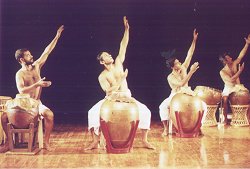 |
 |
GANAPATI - A theatre piece
presented by Veenapani Chawla at Kulavai 2002
March, 2002 |
 |
| Kulavai
-2002 was the two day theatre festival organised by "Voicing Silences"
- a women's activist group. This year Kulavai was giving prominence to
the women directors, their vision and work, taking into account that the
very term " women director" and the concepts supporting its validity has
suffered marginalisation in the hands of mainstream theatre protagonists
and needs reaffirmation and support. The seminar was followed by three
productions by women directors, one of which was "Ganapati" by Veenapani
Chawla. "Ganapati" has been shown in Chennai once before during the Other
Festival 2001. However, even for those who have seen it , it was a delight
in sound-images.
The director's note says, "Every external expression, be it mudra or facial or physical or a netra abhinaya (expressive acting by means of eyes) is informed by a breath which is rhythmic. Similarly all inner motivation is informed by rhythm. As the breath behind the abhinaya is the physical expression of thought and emotion, in the same manner the rhythm in Koodiyattam (Sanskrit drama performed in Kerala) is behind the performer as an unwritten or unspoken text". The whole piece
is structured around rhythm, rhythm produced by various musical instruments
used in different parts of India. The main instrument is the Mizhavu, (a
huge heart shaped instrument which has a narrow opening which is covered
by calf's leather), used as an accompaniment in Koodiyattam. There
were four of them placed diagonally across the stage. Behind each
were the musicians - performers drumming with the palms of their hands.
Says Veenapani, "Using rhythm as a signifier, this performance is structured
in a recurring motif of creation, celebration, destruction and return,
which parallels the motif in the birth stories of Ganapati and
There are, therefore two aspects to the structure, the story aspect and the abstract motif of creation, celebration, destruction and return. The story aspect is just used as a reference through the minimal verbal text. The rest is done through the inferences made through the rhythm, which resonates the abstract motif. To those who are familiar with the rhythmic patterns used for all festivals in Kerala, the creation, celebration, destruction and return motif is suggested through the ascension in the sound pattern from the low to a high and then a return to the low and commencement of the cycle once again The motion is circular and suggests the never-ending pattern of life as seen by the Indian philosophers and thinkers. When Ganapati is killed by Siva and then brought to life by attaching an elephant’s head to his body, the audience see clearly two things, that there is a creation after every destruction and that every creation has in it the element of destruction. The actors say the words and act it out through gestures and movements taken from Kathakali, but it is the rhythms, which take it beyond the specific to the abstract. The stories as well as the transformation of the actor into a musician and vice versa are to Veenapani, suggestive of the creative excellence, which emanates only from hybridity. It is a very
unusual piece of theatre in the sense that it extends the boundaries and
possibilities of theatre to the maximum. The experimentation is a very
conscious process, pushing the norms of theatre to its very limits and
exploring new possibilities in the very idea of theater. We are forced
to ask the question, "What is theatre"? The balance between the spoken
and the musical aspect of sound is tilted and rhythm takes over. Another
boundary that is crossed is that which exists in traditional theatre between
the actor and the musician. The actor plays on the drum, the drummer moves
and acts. The concept of acting also undergoes a change; the actor not
only performs
Veenapani does
not consciously try to address gender issues. But having seen all her productions,
this writer feels that in all her themes she has addressed the issue of
the feminine - the creative and intuitive aspect of the human brain.
Her search for the new or the alternative theatre is also suggestive of
a new space, which the feminist theatre is looking for. Again, her own
individual quest for inspiring moments in theatre is more indicative of
the "personal" merging with the "public" rather than the insistence of
single authorship. Whatever be the audience reaction to her theatre,
we have to accept that it explores the unknown, challenges the known and
allows intellectual and spiritual meanderings.
|
| Vasanti Sankaranarayanan, is a PhD holder from Madras University on the subject “Malayalam Cinema, Society and Politics of Kerala”. She has translated books from Malayalam to English and vice versa and has written some dance scripts. She is a freelance journalist and art critic. |  |